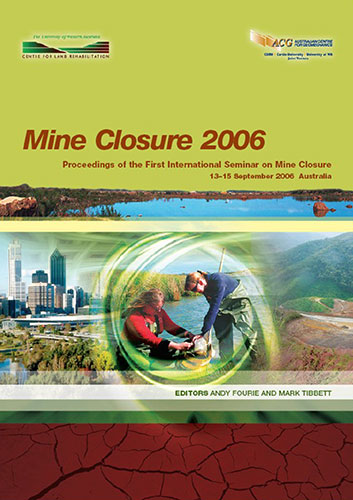Soil Water Retention Properties as the Key Driver for Rehabilitation

|
Authors: Hattingh, R; Viljoen, C |
DOI https://doi.org/10.36487/ACG_repo/605_28
Cite As:
Hattingh, R & Viljoen, C 2006, 'Soil Water Retention Properties as the Key Driver for Rehabilitation', in AB Fourie & M Tibbett (eds), Mine Closure 2006: Proceedings of the First International Seminar on Mine Closure, Australian Centre for Geomechanics, Perth, pp. 351-358, https://doi.org/10.36487/ACG_repo/605_28
Abstract:
Ticor South Africa is a heavy minerals mining and beneficiation operation on the east coast of South Africa. The company commenced operations in April 2001 with the opening of Hillendale Mine. This particular operation has a limited life (10 years), with the result that closure planning commenced four years after mining started. The pre-mining land use is commercial sugar cane production, and the measurement of post- mining rehabilitation success is therefore quantifiable. South Africa has a rapidly evolving legislation with regards to environmental issues. Major revisions of the national statutes regulating water consumption and use, mine environmental management, air quality management, biodiversity and general environmental management have taken place in the past decade. To compound the situation the different aspects are governed by a number of government departments. Although the state has made efforts to defragment the legislative environment, we still have a situation where the goalposts are changing and an operation is answerable to a host of regulators, with few or no standards against which the success of rehabilitation may be measured. Obtaining final mine closure in this specific context could therefore be problematic. For these reasons we decided to develop a rehabilitation and closure strategy from first principles. A series of workshops were held incorporating scientists from a number of backgrounds. From the workshops a strategy was compiled and series of projects generated aimed at achieving closure of the operations within two years of operations ceasing. This closure strategy as well as subsequent work showed that the soil water retention properties of the top layer of the backfilled dunes are one of the most important issues to address during rehabilitation. The intent of this paper is to introduce the concept of a phased, fundamental approach to rehabilitation, as dictated by the key drivers in the system.
References:
Allen, R.G., Pereira, L.S., Raes, D. and Smith, M. (1998) Crop evapotranspiration. Guidelines for computing crop water
requirements, Irrigation and Drainage Paper No. 56, FAO, Rome, Italy 1998.
Birkland, P.W. (1984) Soils and Geomorphology, 372 p. Oxford University Press: New York.
Campbell, G.S. and Diaz, R. (1988) Simplified soil-water balance models to predict crop transpiration. In F.R. Bidinger
and C. Johansen (eds), Drought Research Priorities for the Dryland Tropics, ICRISAT, India.
Chamley, H. (1989) Clay Sedimentology, 623 p., Springer-Verlag, Berlin.
Clemence, B.S.E. (1997) A brief assessment of a weather data generator (CLIMGEN) at South African sites. Water SA
23, pp. 271-274.
Fortmann, R.R. (1998) Report on the effects of future sugarcane production following mining operations at Hillendale
farm. Unpublished Report, South African Sugar Association Experimental Station.
Gee, G.W. and Bauer, J.W. (1986) Particle Size Analyses: Laboratory Methods. Methods of Soil Analyses, Part 1.
Physical and Mineralogical Methods. Agronomy Monograph no. 9: 2nd Edition, pp. 383-411. ASA-CSSA-
SSSA, Madison, Wisconsin, United States of America.
Hillel, D. (1982) Introduction to Soil Physics. Academic Press Inc. Orlando, Florida, 32887.
Klute, A. (1986) Water Retention: Laboratory Methods. Methods of Soil Analyses, Part 1. Physical and Mineralogical
Methods. Agronomy Monograph no. 9: 2nd Edition, pp. 635-662. ASA-CSSA-SSSA, Madison, Wisconsin,
USA.
Monteith, J.L. (1977) Climate and efficiency of crop production in Britain. Philosophical Transactions of the Royal
Society of London, Series B (281), pp. 277-294.
Nahon, D. (1986) Evolution of iron crusts in tropical landscapes. Rates of chemical weathering of rocks and minerals,
S.M. Colman and D.P. Dether (eds), pp. 169-191, Academic Press, New York: London.
Richardson, C.W. and Wright, D.A. (1984) WGEN: A Model for Generating Daily Weather Variables. United States
Department of Agriculture, Agricultural Research Services (1984).
Robbins, C.H. (1991) Solute transport and reactions in salt-affected soils. Agronomy Monograph no. 31: Modeling
plant and soil systems, R.J. Hanks and J.T. Ritchie (eds), ASA-CSSA-SSSA, Madison, Wisconsin, USA.
Snyman, K. (2001) Inherent Natural Resources and Agricultural Potential of Hillendale Empangeni. Unpublished
Report, LRI Associates.
Tanner, C.B. and Sinclair, T.R. (1983) Efficient water use in crop production: research or re-search? Limitations to
Efficient Water Use in Crop Production, H.M. Taylor, W.R. Jordan and T.R. Sinclair (eds), ASA-CSSA-SSSA,
677 Madison, Wisconsin, United States of America, pp. 1-27.
Tinley, K.L. (1986) Coastal Dunes of South Africa. South African National Scientific Programmes Report, 109: 300 p.
Ware, C.I., Whitmore, G.P. and Uken, R. (2001) Evolution of the Northern KwaZulu-Natal Coastal Dune Cordon,
South Africa, Evidence from Clays, International Heavy Minerals Conference, Fremantle, WA, 2001.
Soil Water Retention Properties as the Key Driver for Rehabilitation R. Hattingh, C. Viljoen
358 Mine Closure 2006, Perth, Australia
© Copyright 2025, Australian Centre for Geomechanics (ACG), The University of Western Australia. All rights reserved.
View copyright/legal information
Please direct any queries or error reports to repository-acg@uwa.edu.au
View copyright/legal information
Please direct any queries or error reports to repository-acg@uwa.edu.au